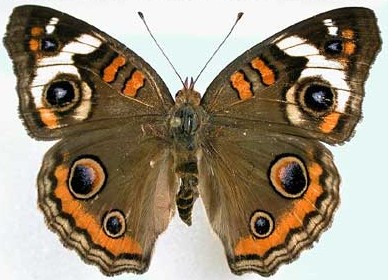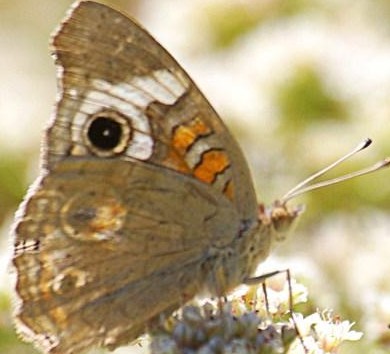 The common buckeye is easily recognized by the striking eyespots that adorn their brown scalloped wings. Although the female is larger than the male and has more rounded forewings, they are otherwise similar in appearance. The forewings have two conspicuous orange bars and a horizontal white band enclosing the larger of the two eyespots. The hind wings have a broad orange marginal band and two eyespots one larger than the other. All eyespots are black with yellow rims and iridescent blue and lilac irises. The underside of the forewings is similar to the upperside but the underside of the hindwings have small or no eyespots. The wing span is up to 2.75 inches. The common buckeye is found in all parts of the US except the northwest and is especially common in the South and California coast. It likes disturbed areas such as old fields, roadsides, gardens, and waste areas.
The common buckeye is easily recognized by the striking eyespots that adorn their brown scalloped wings. Although the female is larger than the male and has more rounded forewings, they are otherwise similar in appearance. The forewings have two conspicuous orange bars and a horizontal white band enclosing the larger of the two eyespots. The hind wings have a broad orange marginal band and two eyespots one larger than the other. All eyespots are black with yellow rims and iridescent blue and lilac irises. The underside of the forewings is similar to the upperside but the underside of the hindwings have small or no eyespots. The wing span is up to 2.75 inches. The common buckeye is found in all parts of the US except the northwest and is especially common in the South and California coast. It likes disturbed areas such as old fields, roadsides, gardens, and waste areas.
 The males are territorial wait on the ground or low plants for females. After mating the females lay their small, stubby, dark green eggs singly on the leaf buds of a variety of host plants. The caterpillars are black with rows of orange cream spots, branched black spines, and orange legs. The black head has orange markings and two short black spines on top. The caterpillars feed singly and form pupae in shades of brown and cream. In warm climates the adult
The males are territorial wait on the ground or low plants for females. After mating the females lay their small, stubby, dark green eggs singly on the leaf buds of a variety of host plants. The caterpillars are black with rows of orange cream spots, branched black spines, and orange legs. The black head has orange markings and two short black spines on top. The caterpillars feed singly and form pupae in shades of brown and cream. In warm climates the adult  butterfly emerges after one to two weeks depending on the temperature, but in cold climates pupae overwinter and the adults emerge in the spring. Adults migrate south from northern climates in fall.
butterfly emerges after one to two weeks depending on the temperature, but in cold climates pupae overwinter and the adults emerge in the spring. Adults migrate south from northern climates in fall.
The host plants are numerous and most are weeds. Plants suitable for the flower garden include snapdragon and frogfruit aka turkey tangle (Phyla nodiflora) . Plants suitable for a wild area include American bluehearts (Buchnera americana), false foxglove (Agalinis spp.), plantain especially common plantian (P. major) and narrowleaf plantain (P. lancelata), toadflax (Linaria sp.), twin flower (Dyschoriste spp.), and firecracker (Ruellia nodiflora). For nectar plants of buckeyes there is heliotrope (Heliotropium sp.), butterfly bush (Buddleia davidii), lantana (Lantana camara), cosmos (Cosmos sp,). Goldenrod (Solidago sp.), and Michealmass daisy (Aster amellus).